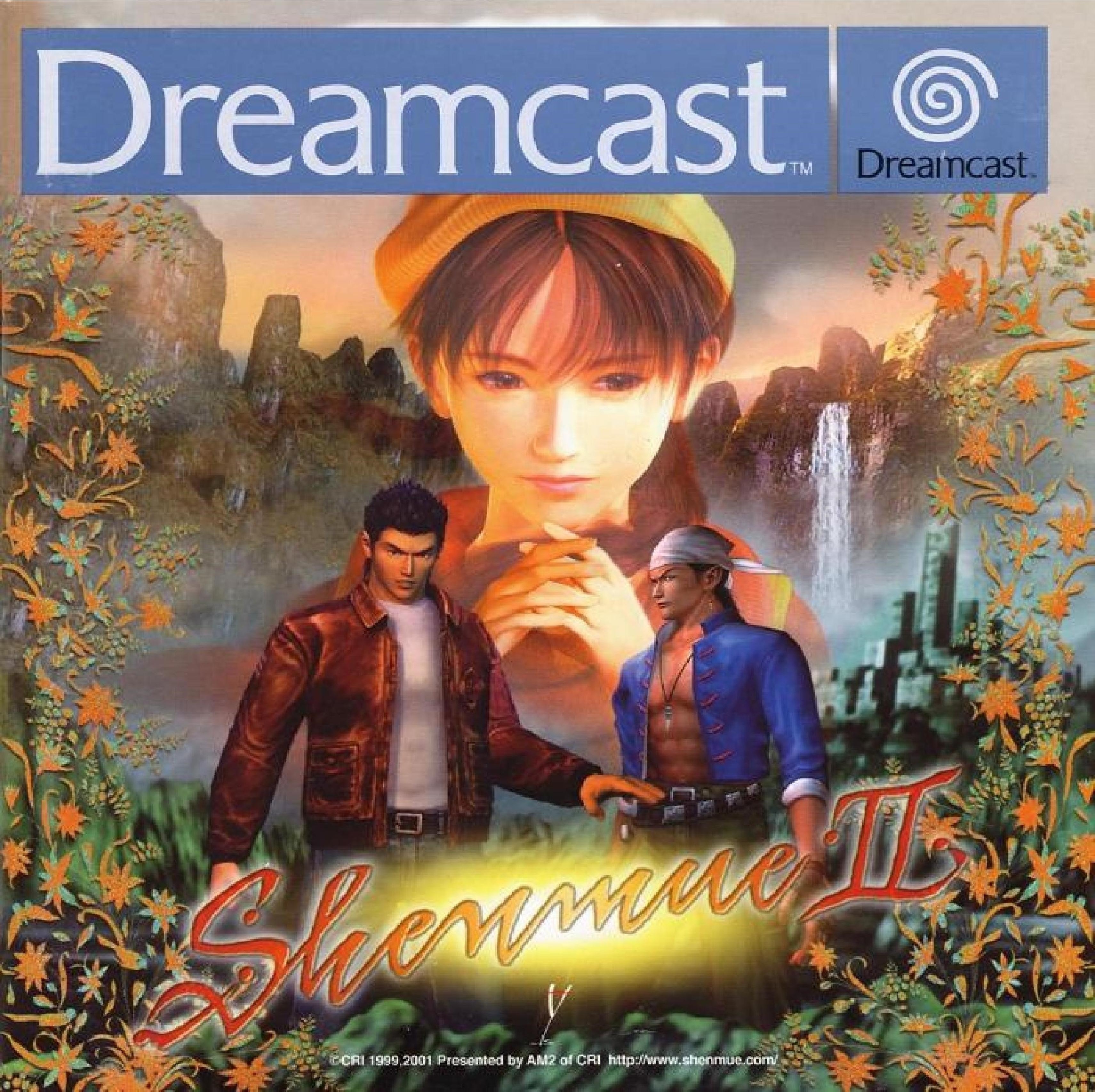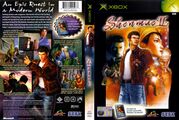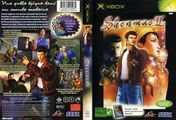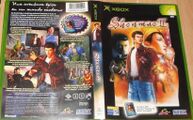Shenmue II
From Sega Retro
| Shenmue II | |||||||||||||||||||||||||||||||||||||||||||||||||||||||||||||||||||||||||||||||||||||
|---|---|---|---|---|---|---|---|---|---|---|---|---|---|---|---|---|---|---|---|---|---|---|---|---|---|---|---|---|---|---|---|---|---|---|---|---|---|---|---|---|---|---|---|---|---|---|---|---|---|---|---|---|---|---|---|---|---|---|---|---|---|---|---|---|---|---|---|---|---|---|---|---|---|---|---|---|---|---|---|---|---|---|---|---|---|
| System(s): Sega Dreamcast, Xbox | |||||||||||||||||||||||||||||||||||||||||||||||||||||||||||||||||||||||||||||||||||||
| Publisher: Sega | |||||||||||||||||||||||||||||||||||||||||||||||||||||||||||||||||||||||||||||||||||||
| Developer: Sega-AM2 | |||||||||||||||||||||||||||||||||||||||||||||||||||||||||||||||||||||||||||||||||||||
| Distributor: Microsoft (EU) | |||||||||||||||||||||||||||||||||||||||||||||||||||||||||||||||||||||||||||||||||||||
| Peripherals supported: Jump Pack, Visual Memory Unit, Dreamcast VGA Box | |||||||||||||||||||||||||||||||||||||||||||||||||||||||||||||||||||||||||||||||||||||
| Genre: FREE Full Reactive Eyes Entertainment[1], Action RPG[2], Adventure[3] | |||||||||||||||||||||||||||||||||||||||||||||||||||||||||||||||||||||||||||||||||||||
| Number of players: 1 | |||||||||||||||||||||||||||||||||||||||||||||||||||||||||||||||||||||||||||||||||||||
|
Shenmue II (シェンムー II) is the direct sequel to Shenmue produced and directed by Yu Suzuki and developed by Sega-AM2. It was originally released for the Sega Dreamcast in 2001 and later the Xbox. Due to exclusivity rights obtained by Microsoft, the Dreamcast version of the game was not released in North America, although had been pencilled in for a release on the 4th December 2001.
Contents
Story
Shenmue II begins shortly after the first installment concluded. While Shenmue told the story of the first chapter of the saga, the second game tells the story of the third, fourth, and fifth chapters. It is possible that at one point, each chapter would receive its own game, however it was likely condensed due to the ambitious scope of the project, and poor Western sales of the first game.
Shenmue II skips the second chapter of the story, detailing events of Ryo Hazuki's trip from Yokosuka to Hong Kong. It was originally released as a comic book (available as an extra in the Xbox version of the game) is only briefly mentioned during the beginning of the game. Instead, Shenmue II starts at the third chapter of the saga, when Ryo has just arrived in Hong Kong.
Following the events of the first game Ryo has travelled to Hong Kong in order to locate Master Lishao Tao. After a difficult search, Ryo finally meets Master Lishao Tao, a woman named Xiuying; but she is unwilling to assist him in what she considers an immoral quest for vengeance. The two part ways, although Xiuying continues to monitor Ryo's progress and they continue to meet on occasion. Through his continued search, Ryo discovers another individual who may be able to assist him in locating Lan Di.
The fourth chapter of the saga takes place in Kowloon, as Ryo attempts to locate Yuanda Zhu; a martial arts expert who sent Iwao Hazuki a letter warning of his impending murder, a warning that arrived too late. At this juncture, several confrontations ensue between Ryo and his allies and the dangerous Yellowheads organization, who are aiming to kidnap Yuanda Zhu on behalf of Lan Di.
The fifth chapter takes place in Guilin. Shortly after arriving, Ryo encounters a young woman named Ling Shenhua. She had previously appeared to Ryo through several dreams throughout the first chapter of the series. As the two converse, it is revealed that the Shenhua family is connected with the legacy of the dragon and phoenix mirrors. Shenhua leads Ryo to a stone quarry on the outskirts of the village to meet with her father, but he is nowhere to be found. The episode comes to an ambiguous end when the pair discover a cryptic note and sword, which Ryo combines with the phoenix mirror and unwittingly sets off a device revealing a huge depiction of the two mirrors. At the game's cliffhanger ending, the sword is seen to float in mid-air.
Gameplay
Shenmue II features gameplay similar to that of its predecessor, Shenmue and shares much of its assets, as the development of multiple Shenmue games overlapped each other. Many assets developed for but unused in the first Shenmue make an appearance in Shenmue II, some of which appeared in pre-releases and demos of the first game, only to be relocated to this one.
Shenmue II is estimated to be roughly five times bigger than the first game[16]. It is less linear than its predecessor, with more options to raise money, and more buttons are used for the QTE segments.
If given a Shenmue save file, the Dreamcast Shenmue II will continue where the player left off in the last game, carrying over any items, the current date (Shenmue starts in November 1986, but ends depending on how fast the player completes his/her quest) and any helpful statistics. While the series was effectively "cancelled" before getting to this point, the original idea was that events may change depending on the choices made in preceeding games. One example is that some optional fighting moves could only be learned in the original Shenmue, and would in theory be inaccessible to those starting from Shenmue II.
This situation is known to have caused some problems, particularly with the Xbox version which has no way of communicating with the first game. As such, blank Shenmue II save files generally have all the items and moves from the first game already set up, including items which serve no practical purpose (which can be therefore be sold for quick cash). Furthermore the game is region locked, in the sense that, for example, a Japanese Shenmue save file will not work with a European copy of Shenmue II. This can be overcome with external utilities.
Unlike the original Shenmue, Shenmue II on the Dreamcast does not have an English voice dub, instead relying on the Japanese one with added subtitles. The Xbox version has this English dub, however (and fan-made patches have subsequently led to English Dreamcast versions too).
History
Development
The Shenmue saga's protracted development time (dating as far back as 1993) means that many of the game's chapters were outlined well in advance of the first Shenmue game releasing. Ryo's journey to Hong Kong is thought to have been some of the earliest Shenmue content to be worked on, to the point where, to all intents and purposes, Shenmue II was announced in 1998 as Shenmue I.
Early gameplay footage and in-engine trailers demonstrated around this period took place almost exclusively in Hong Kong, and descriptions of the game's plot broadly matched what is seen in Shenmue II. It was only during 1999 that the first chapter, Yokosuka, was greatly expanded on from being a (presumably) short introduction set 30 years prior to the main game[17], into a fully fledged Shenmue game in its own right (and taking place in the 1980s, alongside the rest of the adventure).
Originally there was not going to be a "Shenmue II", however to meet deadlines Yu Suzuki's project was split in two, with the first chapter set to appear in August 1999[18] (which it missed) and the second in December[19]. For the US release, both halves would be distributed as the same package[19], but as time went on, the first part was expanded, the second part delayed (into 2001), and further parts were planned.
Shenmue II covers chapters 3, 4 and 5, however chapter 2, set between the journey from Japan to Hong Kong, is absent from the game, being relegated to a comic book. It can only be assumed at some point that, like the other chapters, chapter 2 was meant to be playable .
Predictably many of the assets (particularly character models and 2D elements) are identical between Shenmue and Shenmue II, with several characters making the jump from the "first" game to the second between prototypes. Likewise, unused content found in Shenmue is used in Shenmue II, and vice versa.
Versions
Despite using Japanese vocals in the Dreamcast version, changes were made to the Western versions of Shenmue II, censoring out some religious references and removing one of the answering machine messages with sexual connotations. The character of Yuan, a transvestite in the Japanese version, is also made female, and is re-dubbed by a Japanese voice actress.
The Xbox version brings a number of technical changes to the game, such as the inclusion of quincunx anti-aliasing to create a cleaner image (however, the Dreamcast's VGA output leads to a shaper image than the Xbox). Texture mip-mapping is also employed with trilinear texture filtering, something absent in the Dreamcast release and indeed all of Sega AM2's previous 3D games. Some textures were also replaced with higher quality versions, most notably Ryu's jacket, and some models are rendered with more polygons, again including Ryo.
Water texturing has been completely re-worked for the Xbox port to create a a more lifelike appearance, however the addition of bloom lighting is more controversial, often giving characters a "glow" in some daylight scenes. At night, however, the effect allows for more realistic neon signs and other lighting effects. Extra motion blur was also added to fight scenes.
Many textures in the Xbox version were changed, and in some cases, background geometry is simplified. All of the in-game jukeboxes are now Rock-Ola branded (as opposed to just "Rock"), and while some texturing errors were fixed (such as one of the OutRun logos being rendered backwards on the playable deluxe cabinet), others have been introduced, or removed entirely. Many of the "glass" textures are missing in the Xbox version for unknown reasons.
In the Xbox version, buildings can also cast shadows, which means the player's own shadow is often not rendered. Curiously the white button on the Xbox controller can be used to apply different visual filters, creating a more cinematic tone should the player desire, while the black button can be used to take screen shots of the game, which are then saved to the Xbox hard drive. The hard drive also plays its part in reducing load times.
The Xbox version of Shenmue II hits 30FPS more consistently than its Dreamcast counterpart, which often dips to 20FPS in more demanding scenes. Dolby Digital 5.1 is also used in select cutscenes, though the majority of the game still operates in stereo.
While supported by the Xbox 360 as a backwards-compatible title, the emulation is not perfect, with performance dips manifesting at certain parts of the game and shadows not rendering at all. Post processing effects such as the aforementioned bloom lighting and motion blur are missing. The visual filters also do not work, simply resulting in the game momentarily pausing.
Production credits
Dreamcast version
- Producer/Director/Game Story: Yu Suzuki
- Plotter: Masahiro Yoshimoto
- Screenplay: Takao Yotsuji
- Game Directors: Shinichi Yoshino, Yoshihiro Okabayashi
- Scenario Director: Takao Yotsuji
- Planning Director: Eigo Kasahara
- Program Director: Makoto Wada
- Design Director: Takehiko Mikami
- Sound Director: Yasuhiro Takagi
- Motion Capture Unit Director: Hiroaki Jinno
- Real Time Movie Director: Kazuya Murata
- Voice Recording Directors: Susumu Aketagawa, Takao Yotsuji
- Promotion Director: Shigeru Ueda
- Production Manager: Mitsuo Kashiwagi
- Sound Production Manager: Tatsutoshi Narita
- Scenario Supervisor: Yu Yamamoto
- Total Advisers: Makoto Osaki, Hiroshi Kataoka
- Assistant Producer: Masanori Ohe
- Director: Takao Yotsuji
- Plotter: Masahiro Yoshimoto
- Free Scenario Managers: Junichi Yoshida, Makoto Goya
- Free Scenario Writers: Yasushi Ohtake, Masatoshi Kurakata, Yoshijiroh Muramatsu, Hideyo Ikeda, Yoshihiro Miyashita, Kiyomi Mizushima
- Free Scenario Checkers: Shu Hiratoh, Katsuyuki Sugano
- Free Scenario Coordinator: Shin Ishikawa
- Free Scenario Proofreader: Tadafumi Wagatsuma
- Free Scenario Character Data Management: Yoshiyuki Fukushima, Yasushi Funakoshi
- Main Dialogue Editor: Toshirou Sasaki
- Dialogue Editors: Izumi Saito, Yasuyo Kudo
- Scenario Section Assistants: Tomohide Takaiwa, Kikuo Shinomiya
- Director: Eigo Kasahara
- Chief Scenario Flow Editor: Shinichi Yoshino
- Scenario Flow Editors: Masanobu Fukazawa, Daisuke Tazaki, Akira Uematsu
- Chief System Planner: Hideo Choumabayashi
- System Planners: Ken Odanaga, Masaaki Somaki, Yasuhiro Kondou
- Event Manager: Yoshihiro Okabayashi
- Chief Event Planner: Misako Hamada
- Event Planners: Satoru Tsuji, Takehiro Imai, Yuuichi Taniguchi, Makoto Suda, Yuji Sobue
- Battle System Manager: Yoshihiro Okabayashi
- Battle System Planners: Hiroyuki Matsumoto, Kentaro Arakawa
- Chief Map & Property Layout Planner: Shin Ishikawa
- Map & Property Layout Planner: Koumei Akazawa
- Script Data Manager: Shin Ishikawa
- Script Data Writers: Tatsuya Ohmachi, Kenji Ishikawa, Masayoshi Takatori, Nobuhiro Onodera
- Script Data Minutes: Tadafumi Wagatsuma, Shinsuke Imai
- Script Data Planning Section Assistants: Junya Kuroki, Hiroshi Nonaka
- Director: Makoto Wada
- Main Programmer: Makoto Wada
- Programmers: Shin Kuroiwa, Tomofumi Muramatsu, Yoichi Ugajin
- Chief System Programmers: Makoto Wada, Takayuki Iida
- System Program Adviser: Takeshi Hirai (UGA)
- System Programmers: Masayuki Sumi, Shigenobu Iga, Norimasa Yoshizawa, Satoru Takeshima, Yoshikazu Nagasawa, Yoshinori Isoda, Toshihiko Gouya, Tetsuya Ino, Souta Kageyama
- Chief Event System Programmers: Takeshi Hisajima, Yusuke Shimizu, Takayuki Iida
- Event System Programmers: Kouji Hanaoka, Takashi Yamaguchi, Takashi Suwa, Takeshi Machida, Shin Kuroiwa, Takayuki Ohta, Tamio Munekata, Tomofumi Muramatsu
- Chief Life Control System Unit Programmer: Takayuki Iida
- Life Control System Unit Programmer: Kensaku Maeda
- Life Control System Unit Data Management: Yusuke Matsuyama
- Life Control System Unit Data Production: Hidetomo Hara, Hitoshi Kagawa, Junichi Yabuki
- Chief Battle System Programmer: Hiroaki Shoji
- Battle System Programmers: Norihiro Sekine, Yasutaka Igarashi, Hideaki Miyagushi
- Chief Real Time Movie Programmer: Yoichi Ugajin
- Real Time Movie Programmer: Kazuhiro Nomura
- Chief 3D Library & Effect Programmer: Takeyuki Ogura
- 3D Library & Effect Programmers: Kazunori Masuda, Junichi Komori, Susumu Morii
- 3D Library & Effect Hang On Porting: Masatoshi Hashimoto, Shinichirou Mukaigashira
- 3D Library & Effect Software Section Assistant: Naoko Kikuchi
- Supervisor: Masanori Ohe
- Director: Takehiko Mikami
- Main 2D Graphics Designer: Kenji Miyawaki
- 2D Graphics Designers: Masaya Saida, Hiroshi Kandou, Erika Aihara
- Main 3D Character Designer: Tetsunari Iwasaki
- 3D Character Designers: Daisuke Saito, Keita Yoshino, Yumiko Sonoyama, Takeshi Itou, Miyuki Noda, Atsuo Takayasu, Rie Sakurai, Eiko Takahashi, Takahito Minei, Chizuka Tamehira, Takashi Yamaguchi, Kayo Yoshida, Hiroshi Hiraga
- 3D Back Ground Managers: Takehiko Mikami, Takumi Matsui
- Main 3D Back Ground Designers: Tatsuya Wakabayashi (Aberdeen), Masahiko Yagi (Wan Chai), Itsuki Watanabe (Wan Chai), Hiroyasu Tamura (Kowloon), Hiroshi Yamada (Kowloon), Masato Nishimura (Guilin), Hiroshi Sengoku (Property)
- 3D Back Ground Designers: Shinya Inoue, Mami Abe, Hiromitsu Sasaki, Makoto Onuma, Haruhiko Miwa, Takahiko Kimura, Yoshimi Soshi, Wataru Sakomura, Norikazu Hirai
- Motion Manager: Toshiya Inoue
- Main Motion Designers: Hiroshi Kawasaki (Battle Motion), Masaya Kusunose (Life Motion), Shigemi Ohmori (Capture)
- Motion Designers: Makiko Ishikawa, Masatoshi Murakami, Naoki Ito, Hideaki Fukai, Hiroshi Mitsuzuka, Takayuki Sorimachi, Shinya Shimada, Katsuhiro Fujita, Kazuyoshi Asami, Takashi Ohta, Takehisa Yoshimura
- Real Time Movie Director: Kazuya Murata
- Chief Real Time Movie Designers: Hiroya Eguchi, Hiroshi Noguchi
- Real Time Movie Designers: Daisuke Tachibana, Shungo Seki, Yuichi Uchida, Takeya Sekiguchi, Jinya Ito, Yoshihiko Suzuki, Eisuke Abe, Naoya Shiozaki, Takashi Furue
- Main Motion Camera Director: Kazuya Murata
- Chief Motion Camera Director: Kazuhiro Fushimi
- Motion Camera Directors: Kazuya Murata, Jun Nakamura, Akihiro Ishihara, Tomokuni Nishimine, Masataka Saito, Yoichi Kaiya
- Motion Camera Design Technical Manager: Nobuyuki Matsuda
- Motion Camera Design Section Assistant: Nozomi Watanabe
- Director: Hiroaki Jinno
- Action & Stunt Director: Sho Tagaya
- Assistant Directors: Kazuhiro Tsuboy, Rei Kato, Genichirou Suzuki, Hitoshi Tawada, Yoko Aoyagi, Yufu Shiomi, Kunihiko Matsunaga
- Research and Development: Hans Van Veenendaal
- Unit Assistants: Tomoko Morikawa, Takeyuki Izumi, Daigo Iwatani
- Cast: Hiroshi Fujioka (Iwao Hazuki), Masaya Matsukaze (Ryo Hazuki), Haduki Ishigaki (Shenhua Ling), Takumi Hagiwara (Wuying Ren)
- Motion Actors/Actresses: Takakazu Tsukamoto, Takuya Tsukamoto, Mayumi Sato, Wataru Murakami, Tetsuhiro Ikeda, Chidori Hirano, Tonbou Horiguchi, Naoyuki Yoshihisa, Yumiko Watanabe
- Stunt Actors/Actresses: Yuichi Aida, Yasuhiko Kashiwa, Yuko Watanabe
- Action Actors/Actresses: Koji Hatta, Ryosuke Shira, Emi Nishitsuji, Misako Nagashima, Sho Tagaya
- Action & Stunt Presents: Wild JP, Phoenix
- Director: Yasuhiro Takagi
- Sound Section Assistants: Seiichi Hamada, Takenobu Mitsuyoshi
- Music Composers: Takenobu Mitsuyoshi, Yuzo Koshiro, Ryuji Iuchi, Takeshi Yanagawa, Satoshi Miyashita, Koji Sakurai, Masataka Nitta, Shinji Otsuka, Fumio Ito, Megumi Takano, Osamu Murata, Shinichi Goto
- Erhu Performed By: Jia Peng-Fang, Yuiran Oyama
- Clipper Tool Supervisor: Takashi Nozawa
- Clipper Tool Programmer: Masao Oshimi
- Sound Effects & Editors: Masataka Nitta, Shinji Otsuka, Masanori Miyamoto, Fumio Ito, Osamu Murata, Shinichi Goto, Seiichi Hamada
- Sound Production Manager: Tatsutoshi Narita
- Arranged By: Hayato Matsuo, Toshiyuki Watanabe
- Album Production: Hiroki Horio, Hideyuki Fujii
- Conducted By: Hiroshi Kumagai
- Music Performed by: Kanagawa Philharmony Orchestra
- Director: Susumu Aketagawa
- Assistant Director: Jin Aketagawa
- Booking Manager: Naoto Matsuse
- Voice Editors: Ryohei Kohno, Akihiko Onda, Hideaki Miyamoto
- Voice Recorders: Naoyuki Machida, Satoru Higashi
- Casting: Kenichi Kuramochi
- Assistant Casting: Toshie Tabata
- Song of Shenhua
- Performed By: Ioli
- Written By: Yumi Asada
- Composed By: Ryuji Iuchi
- Orchestra Arranged By: Hayato Matsuo
- Asamoya No Namioto
- Composed & Orchestra Arranged By: Toshiyuki Watanabe
- Joy
- Vocal: Minoru Niihara
- Bass: Sachio Ogawa
- Guitar: Yasuo Yokozawa
- Drums: Hisamitu Imai
- Written By: Tomoaki Inoue
- Composed By: Shinji Otsuka
- Directed By: Tatsutoshi Narita
- Technical Research Dept. General Manager: Takashi Fujimura
- Technical Research Dept. Assistant General Manager: Kanji Omatsu
- Technical Research Dept. Section Manager: Shigenobu Nakamura
- Technical Research Dept. Section: Toshinobu Sakurai, Masaya Takeshige, Tatsuya Suizu, Takashi Tanaka, Takeharu Tanimura, Takeshi Ogawa, Akira Kudo, Kai Ogura
- Technical Research Dept. Motion Capture Section: Hans Van Veenendaal, Yaekko Okadaya, Takeo Iwata
- Technical Research Dept. Network Section Manager: Tohru Kobayashi
- Technical Research Dept. Network Section: Keishi Suzuki, Yoshitaka Higashiyama, Yasuyuki Komiya, Yuji Miyata, Takahiro Igarashi, Haruki Kubota
- Director: Shinichi Yoshino
- Debug Management: Hiroshi Nishida, Kazuyoshi Terada
- Debug Foremen: Motokazu Tsubono, Atsushi Miyamoto, Daisuke Hosogi, Yu Furukawa
- Debuggers: Daisuke Yamaguchi, Kouji Ohno, Motoyo Ishikawa, Kei Terui, Shinichiro Inoue, Kanako Kuwabara, Yousuke Ito, Masaichi Taira, Makoto Tanaka, Jun Matsumoto, Kazutoshi Watanabe, Hiroyuki Natsume, Yasumoto Kanemaru, Takahiro Kodama, Takeshi Yokoyama, Manabu Sato, Shoji Uehara, Takehiro Suzuki, Kouji Nishiyama, Kouhei Imura, Mitsuaki Kato, Tomoko Ogura, Kazumi Suzuki, Hironobu Oka, Makoto Hosaka
- Producer: Shigeru Ueda
- Manager: Yasunobu Masahiro, Yasushi Nagumo
- Coordinators: Junichiro Hirata, Takayoshi Ohuchi, Kazuhiro Asami
- Marketing Producer: Nasanao Madea
- Marketing Manager: Seurio Sannabe, Hiroyuki Yamashita
- Marketing Director: Yasushi Yamashita
- Publicity Staff: Fumio Goto, Kenji Arui, Taku Kihara, Goro Iwasaki, Tetsune Nakazone, Hajime Hiratsuka
- Publicity Designers: Akira Yamanaka, Kazunori Oii
- Managers: Mitsuo Kashiwagi, Yasushi Nakajima
- Assistant Managers: Miki Komine, Takami Shibasaki, Sayaka Watanabe, Yukiko Hirano
- Director: Shin Ishikawa
- Localization Staff: Hiroshi Noguchi, Izumi Satio, Masayoshi Takatori, Nobuhiro Onodera, Shu Hiratou, Toshirou Sasaki, Yasuyo Kudo, Yuichi Taniguchi
- Tenslation Producer: Koji Kobayashi (Jay Film Co. Ltd.)
- Tenslation Supervisor: Kay Miura (Jay Film Co. Ltd.)
- Draft Tenslation: Word box Inc.
- Main Software Programmer: Makoto Wada
- Software Programmers: Shin Kuroiwa, Tomofumi Muramatsu, Yoichi Ugajin
- 2D Graphics Main Designer: Kenji Miyawaki, Masaya Saida, Hiroshi Kandou, Erika Aihara
- U.S. Executive in Charge: Shinobu Toyoda
- Localization Coordination: Jin Shimazaki, Osamu Shibamiya
- Script Editors: Berjes Enriquez, Mabel Chung, Demetrius Grippin, Catherine Yu, Jason Kuo
- Senior Product Manager: Rob Alvarez
- Assistant Product Manager: Cord Smith
- Director Product Marketing: John Golden
- Public Relations: Gwen Marker, Teri Higgins
- Director Event Planning: Kathleen Joyce
- Creative Services: Angela Santos, Robert Schonfisch
- Test Lead: Berjes Enriquez
- Assistant Test Leads: Mavel Chung, Demetrius Griffin, Catherine Yu
- Testers: Tom Fong, Kari Hattner, Derek Wong, John Yu, Blaier Sondker
- Director Of PD: Kats Sato
- Localization Producer: Kuniyo Matsumoto
- Product Marketing Manager: Jim Pride, Mathew Quaeck
- Text Translator (France): Caroline Ruiz
- Text Translator (Germany): Jens Geffert
- Text Translator (Spain): Enrique Gonzalez
- Lead Tester: Matthew Brooks
- Hakkyuku Ken Motions Supervisor: Master Gorenshi
- Writer: Toshiyuki Tanka
- Planners: Katsunori Yamaji, Shigeki Terajima, Isao Murayama, Akihito Ohta, Kenji Takei, Kenichi Oguchi, Masaki Harada, Yousuke Yamashita, Toshiaki Motozawa, Norihiro Sawada, Chie Ishigaki
- Programmers: Keiji Okayasu, Masashi Hayashida, Nobuyuki Sugano, Keiichi Yamamoto, Hiroyuki Tsuzuki, Manabu Matsumoto, Hajime Ikebe, Sumito Aso, Takatoshi Tatsumi, Kenichi Matsumura, Kennosuke Koga, Hirohiko Yoneda
- Designers: Hideki Kawabata, Yasushi Kameda, Kentarou Nishimura, Hideyuki Ohi, Yumiko Dobashi, Mio Saito, Takehiro Izumo, Teruya Suzuki, Eui Tokumori, Fumiyo Tanaka, Tomotaka Shuroichi, Kentarou Hikita, Manabu Satou, Takahiro Matsumoto
- Publicity Section: Ai Kotani, Akemi Shimizutani, Utako Okukawa, Ryoko Raita
- Production Assistants: Sadako Hattori, Mio Oguchi
- R&D Dept.#2 Visual Editing Supervisor: Masanori Ohe
- R&D Dept.#2 Visual Editing Manager: Makoto Ando
- R&D Dept.#2 Visual Editors: Naonori Wantanabe, Mikako Suzuki, Takeya Sekiguchi
- JAY FILM Executive Producer: Shuichi Kakesu
- JAY FILM Producer: Koji Kobayashi
- JAY FILM Assistant Producer: Soutaro Maeda
- Promotion: Libero, Polydor K.K
- Acotors/Actresses & Extra: Phoenix, Wild Stunt Team, Himitsukiti
- Voice: 81 Produce, Office C.A Planning, Magic Capsule Co. Ltd
- Production: Advanced Technology & Information, Ancient, Arc System Works Co. Ltd, Avant Inc., Creek & River Co. Ltd, CSK Research Institute Corp., DigitalScape Co. Ltd, Garguyle Mechanics Inc., Hitachi Ltd., Media Desgin & Art Ltd., Media Entertainment, Junge Corp., Orental Light & Music Inc., Receuit Staffing Co. Ltd., Sims Co. Ltd., Studio Limited Partership, Toshiba Emi, T's Music, Arewana, DDL Corporation, Dreams Co. Ltd., Rutubo Games, Shangrila Corporation, Studio Cilps
- Marerial Offer: Amusement Vision Ltd., Hitmaker Co. Ltd, Overworks Ltd., Smilebit Corp., Sonic Team Ltd., WOW Entertainment Inc.
- Development Tools: ADX, MPEG Sofdec, ROFS
- The Up With: Soft Drinks, Timex, Zippo, Hitachi
- Created By: Sega-AM2
- Presented by: Sega
- Director of Product Development: Kats Sato
- Localization Producer: Kuniyo Matsumoto
- French Translator: Caroline Ruiz
- German Translator: Jens Geffert
- Spanish Translator: Enrique Gonzalez-Farjado
- Lead Tester: Matthew Brooks
- Product Marketing Manager: Jim Pride, Mathew Quaeck
- Localisation/Design Co-ordinator: Emma Ledda
- Designer: Tom Bingle
Xbox version
- Executive Producer: Hisao Oguchi
- Producer: Yu Suzuki
- Director: Yu Suzuki, Shin Ishikawa
- Chief Planner: Misako Hamada
- Planners: Shu Hiratou, Masahiro Katsuta, Nobuhiro Onodera, Akihiko Sasaki
- Main Dialogue Data & Script Data Editors: Toshirou Sasaki, Nobuhiro Onodera
- Dialogue Data & Script Data Coordinator: Hiroshi Noguchi
- Producer: Koji Kobayashi
- Translation Supervisor: Kei Miura
- Draft Translation: Word Box Inc.
- Director: Hironobu Tsujikawa
- Programmers: Makoto Sato, Ryutaro Hayakawa, Masatoshi Kawada, Tomonori Sato, Norimasa Yoshizawa, Masanori Sato, Masanori Sakurai, Kenichiro Tabata, Hajime Iwamoto, Takashi Kato (Multimedia Laboratory)
- Hang On Porting: Masatoshi Hashimoto, Shinichirou Mukaigashira
- Space Harrier Porting: Rutubo Games
- OutRun Porting: Rutubo Games
- Afterburner II Porting: Rutubo Games
- Program Supervisor: Makoto Wada
- Main 2D Graphic Designer: Kenji Miyawaki
- 2D Graphic Designers: Masaya Saida, Erika Aihara
- Main 3D Graphic Designer: Mami Abe
- 3D Graphic Designers: Kouhei Nozaki, Kozue Suzuki
- 3D Graphic Design Supervisor: Toshiyuki Adachi
- Director: Seiichi Hamada
- Sound Section Assistant: Yasuhiro Takagi
- Sound Effects & Editors: Seiichi Hamada, Yasuhiro Takagi
- 5.1ch Sound Director: Tatsutoshi Narita
- 5.1ch Sound Editor: Shinichi Goto
- Voice Editors: Keisuke Tsukahara, Hideaki Miyamoto, Seiichi Hamada
- Voice Recorders: Naoyuki Machida, Satoru Higashi, Hideaki Miyamoto
- Sound Production Manager: Tatsutoshi Narita
- Executive Voice Recording Producer (JAY FILM Co.,Ltd.): Shuichi Kakesu
- Voice Recording Producer (JAY FILM Co.,Ltd.): Koji Kobayashi
- Voice Recording Supervisor (JAY FILM Co.,Ltd.): Kei Miura
- Voice Recording Director (JAY FILM Co.,Ltd.): Hirotaka Tashiro
- Assistant Voice Recording Director (JAY FILM Co.,Ltd.): Hiroshi Noguchi
- Voice Recording Chinese Supervisor (JAY FILM Co.,Ltd.): Chen Yu
- Voice Recording Production Coordinator (JAY FILM Co.,Ltd.): Megumi Igei
- Assistant Voice Recording Manager (JAY FILM Co.,Ltd.): Yu Tamura
- Voice Recording Production Account (JAY FILM Co.,Ltd.): Naoko Kawasaki
- Director: Misako Hamada
- Debuggers: Yousuke Ito, Takeshi Yokoyama, Ayumi Kudou, Atsushi Miyamoto
- Foreign Debuggers Management Director: Hiroshi Noguchi
- Foreign Debuggers Management Coordinator: Megumi Igei
- Foreign Debuggers: William Burden, David Schaaf, Steven Levithan, Nicholas J. Schaaf, Chia Gilli
- Translation Foremen: Hiroshi Noguchi, Shu Hirato
- Publicity: Kazuyoshi Terada
- Visual Editing Section Editor: Naonori Watanabe
- Assistant Visual Editing Section Editor: Hidekuni Ohta
- Localization Supervisor: Keisuke Chiwata
- 3D Graphics Designers: Satoshi Fujinuma, Seiji Aoki, Kazuya Suzuki, Masayuki Takahashi, Kazuya Morita, Yuichi Matsui
- Special Thanks: Masanao Maeda, Masahiro Nakagawa, Hitoshi Okuno, Kouji Kuroki, Sega of America Dreamcast Inc., Sega Europe Ltd.
- Actors/Actresses & Extras: Phoenix, Wild Stunt Team, Himitsukiti
- Voices: Compozila Co. Ltd, Aoni Production Co. Ltd, Inagawa Motoko Office, Ist Co. Ltd, Triple Sun Talent, Word Box Inc
- Production: Advanced Technology & Information Inc, Ancient, Arc System Works Co. Ltd, Avant Inc., Creek & River Co. Ltd., Digitalscape Co. Ltd, Gargoyle Mechanics Inc., Hitachi Ltd., Jay Film Co. Ltd, Jungle Corp., Media Design & Art Ltd., Media Entertainment Inc., Oriental Light & Magic Inc., Recruit Staffing Co. Ltd., Sims Co. Ltd., Studiofake Limited Partnership, Toshiba Emi, T's Music Co. Ltd., Arowana, DDL Corporation, Dreams Co. Ltd, Rutubo Games, Shangri-La Cotporation, Studio Clips
- Material Offer: Amusement Vision Ltd., Hitmaker Co. Ltd., Overworks Ltd., Smilebit Corp., Sonic Team Ltd., WOW Entertainment Inc.
- Development Tools & Middleware: CRI Middleware Co. Ltd., MPEG Sofdec, ADX, ROFS
- The Up With: Sapporo Soft Drinks, Timex, Zippo, Hitachi, Microsoft, Sega
- Created By: Sega-AM2
- Presented by: Sega
Magazine articles
- Main article: Shenmue II/Magazine articles.
Promotional material
- Main article: Shenmue II/Promotional material.
Physical scans
Dreamcast version
| Sega Retro Average | |||||||||||||||||||||||||||||||||||||||||||||||||||||||||||||||||||||||||||||||||||||||||||||||||||
|---|---|---|---|---|---|---|---|---|---|---|---|---|---|---|---|---|---|---|---|---|---|---|---|---|---|---|---|---|---|---|---|---|---|---|---|---|---|---|---|---|---|---|---|---|---|---|---|---|---|---|---|---|---|---|---|---|---|---|---|---|---|---|---|---|---|---|---|---|---|---|---|---|---|---|---|---|---|---|---|---|---|---|---|---|---|---|---|---|---|---|---|---|---|---|---|---|---|---|---|
|
| 89 | |
|---|---|
| Based on 19 reviews | |
| Dreamcast, JP (Shokai Genteiban) |
|---|
| Dreamcast, JP (Dorikore) |
|---|
|
Xbox version
| Sega Retro Average | ||||||||||||||||||||||||||||||||||||||||||||||||||||||
|---|---|---|---|---|---|---|---|---|---|---|---|---|---|---|---|---|---|---|---|---|---|---|---|---|---|---|---|---|---|---|---|---|---|---|---|---|---|---|---|---|---|---|---|---|---|---|---|---|---|---|---|---|---|---|
|
| 85 | |
|---|---|
| Based on 10 reviews | |
Technical information
The real-time opening cutscenes render 1.8 million polygons per second, at 30 frames per second and 60,000 polygons per frame.
Technical information
ROM dump status
| System | Hash | Size | Build Date | Source | Comments |
|---|
External links
References
- ↑ File:Shenmue2 jp dc back cover.jpg
- ↑ 2.0 2.1 2.2 2.3 2.4 2.5 2.6 http://sega.jp/dc/010901/ (Wayback Machine: 2014-08-03 00:20)
- ↑ https://sega.jp/history/hard/dreamcast/software.html (Wayback Machine: 2020-11-07 20:31)
- ↑ Dreamcast Magazine, "No. 25" (UK; 2001-08-09), page 8
- ↑ http://www.amazon.co.uk/exec/obidos/tg/browse/-/656042/ (Wayback Machine: 2001-11-25 06:01)
- ↑ https://groups.google.com/g/uk.games.video.dreamcast/c/TsEPLNY-HYM/m/WpVruOoem0kJ
- ↑ Dreamcast Magazine, "No. 30" (UK; 2001-12-27), page 38
- ↑ 8.0 8.1 GamePro, "January 2003" (US; 200x-xx-xx), page 136
- ↑ Xbox.com (en-US; default.htm/) (Wayback Machine: 2005-03-12 00:11)
- ↑ http://www.amazon.co.uk/Microsoft-Shenmue-II-Xbox/dp/B000083XHN (Wayback Machine: 2008-09-22 14:13)
- ↑ Xbox.com (en-gb; default.htm/) (Wayback Machine: 2005-04-28 03:23)
- ↑ https://www.amazon.fr/S%25C3%25A9ga-Shenmue-2/dp/B00008GQYF/ (Wayback Machine: 2019-08-24 21:04)
- ↑ http://www.amazon.de/Microsoft-Shenmue-II/dp/B00008Y2IO (Wayback Machine: 2007-12-12 15:37)
- ↑ Xbox.com (en-AU; default.htm/) (Wayback Machine: 2005-04-11 15:33)
- ↑ https://www.amazon.it/Microsoft-Shenmue-II-Xbox/dp/B000083XHN/ (Wayback Machine: 2019-08-24 21:07)
- ↑ Dreamcast Magazine, "No. 30" (UK; 2001-12-27), page 42
- ↑ Next Generation, "April 1999" (US; 1999-03-16), page 24
- ↑ Edge, "June 1999" (UK; 1999-05-19), page 14
- ↑ 19.0 19.1 Next Generation, "October 1999" (US; 1999-09-21), page 37
- ↑ File:Shenmue II (Discs 1 & 2) DC EU Manual.pdf, page 81
- ↑ 100% Consoles, "Décembre 2001" (FR; 2001-1x-xx), page 100
- ↑ 576 Konzol, "November 2001" (HU; 2001-xx-xx), page 50
- ↑ Bonus, "1/2002" (YU; 2002-01-25), page 60
- ↑ Consoles +, "Octobre 2001" (FR; 2001-xx-xx), page 120
- ↑ Digitiser (UK) (2001-12-21)
- ↑ Dreamcast Magazine, "No. 29" (UK; 2001-11-29), page 38
- ↑ Dorimaga, "2001-08 extra (2001-09-21)" (JP; 2001-09-07), page 34
- ↑ Dorimaga, "2002-18 (2002-10-11)" (JP; 2002-09-27), page 32
- ↑ Edge, "Christmas 2001" (UK; 2001-11-29), page 84
- ↑ Entsiklopediya igr dlya Dreamcast, "Izdaniye chetvertoye, dopolnennoye" (RU; 2002-xx-xx), page 206
- ↑ Famitsu, "2001-09-14" (JP; 2001-08-31), page 33
- ↑ GamesMaster, "Xmas 2001" (UK; 2001-1x-xx), page 80
- ↑ MAN!AC, "01/2002" (DE; 2001-12-05), page 56
- ↑ Playbox, "Février 2002" (FR; 200x-xx-xx), page 32
- ↑ Play, "Marzec 2002" (PL; 2002-xx-xx), page 27
- ↑ PSX Extreme, "11/2001" (PL; 2001-1x-xx), page 23
- ↑ PSX Extreme, "01/2002" (PL; 2002-0x-xx), page 53
- ↑ Power Unlimited, "Jaargang 10, Nummer 2, Februari 2002" (NL; 2002-0x-xx), page 44
- ↑ Strana Igr, "Oktyabr 2001 2/2" (RU; 2001-xx-xx), page 48
- ↑ Consoles +, "Avril 2003" (FR; 2003-0x-xx), page 102
- ↑ Electronic Gaming Monthly, "December 2002" (US; 2002-11-05), page 273
- ↑ GameNOW, "December 2002" (US; 2002-11-12), page 60
- ↑ Hyper, "March 2003" (AU; 2003-02-05), page 68
- ↑ Official Xbox Magazine, "February 2003" (UK; 2003-xx-xx), page 94
- ↑ PSX Extreme, "01/2003" (PL; 2003-0x-xx), page 71
- ↑ Quit, "Marzo 2003" (IT; 2003-0x-xx), page 25
- ↑ Super Juegos, "Junio 2003" (ES; 2003-0x-xx), page 60
- ↑ Xbox Zone, "02/2003" (DE; 2003-0x-xx), page 46
| Shenmue II | |
|---|---|
|
Main page | Comparisons | Credits | Development | Magazine articles | Video coverage | Reception | Promotional material | Compliance | Technical information | Bootlegs
Music: Shenmue II (2021) | |
- Jump Pack-compatible games
- Dreamcast VGA Box-compatible games
- Visual Memory Unit-compatible games
- 1 player games
- JP Dreamcast games
- All JP games
- EU Dreamcast games
- All EU games
- DE Dreamcast games
- All DE games
- ES Dreamcast games
- All ES games
- FR Dreamcast games
- All FR games
- UK Dreamcast games
- All UK games
- Dreamcast games
- 2001 Dreamcast games
- All 2001 games
- Dreamcast adventure games
- All adventure games
- US Xbox games
- All US games
- DE Xbox games
- ES Xbox games
- FR Xbox games
- UK Xbox games
- FI Xbox games
- All FI games
- IT Xbox games
- All IT games
- AU Xbox games
- All AU games
- Xbox games
- All 2002 games
- 2002 Xbox games
- All games
- Credits without source
- Credits without reference
- Old-style rating (gi)
- Old-style rating (gamenow)
- Old-style rating (gamepower)
- Old-style rating (gamesmaster)
- Old-style rating (superjuegos)
- External rating reference
- Rating without PDF source
- Old-style rating (techtv)
- Old-style rating (videogames)
- Old-style rating (xboxworld)
- Update ratings template
- 8 old ratings
- No ROM dumps
- Missing ROM dumps
- Old technical information
- Shenmue II
- Shenmue (franchise)




































